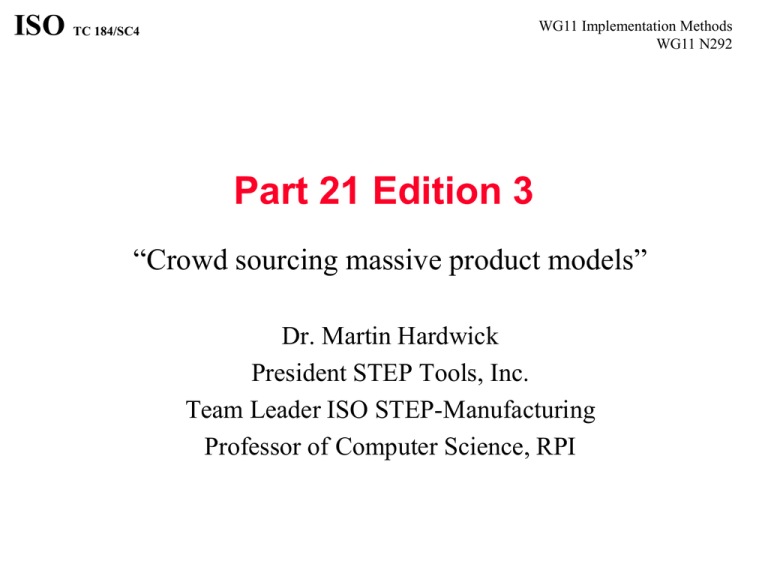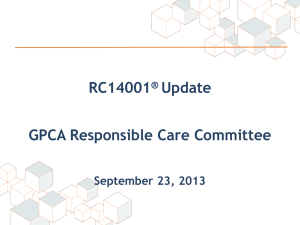WG 11 - STEP Tools, Inc.
advertisement

ISO TC 184/SC4
WG11 Implementation Methods
WG11 N292
Part 21 Edition 3
“Crowd sourcing massive product models”
Dr. Martin Hardwick
President STEP Tools, Inc.
Team Leader ISO STEP-Manufacturing
Professor of Computer Science, RPI
ISO TC 184/SC4
WG11 Implementation Methods
WG11 N292
Crowd Sourcing
Massive Product Models
• Design of a complete aircraft, ship or vehicle
• Manufacturing operations across a supply chain
• Construction of a skyscraper
• The models are massive
• The models are made by thousands and used by millions
• The models will require extensive programming outside of
a single CAD, CAM or BIM system
ISO TC 184/SC4
WG11 Implementation Methods
WG11 N292
Available Elements
• Extensible information models
– STEP for design
– STEP-NC for manufacturing
– IFC for building and construction
– Other file types – JT, XML, 3DPDF etc
• CAD, CAM and BIM systems that can make data for very
large fragments of the models
ISO TC 184/SC4
WG11 Implementation Methods
WG11 N292
Part 21 Editions 1 & 2
• Very successful - edition 1 in 1994, edition 2 in 2002
– Implemented by all the CAD, CAM and BIM vendors.
– Upward compatible across many, many enhancements.
– Very fast performance by translation systems.
• Designed for easy implementation
– Minimal data format for maximal upward compatibility.
– No URI’s, OIDs of other fancy features.
– No concessions to easy data presentation.
ISO TC 184/SC4
WG11 Implementation Methods
WG11 N292
Issues with Edition 1 & 2
• The file format was designed to be written by one system
in its entirety, and read by another system in its entirety.
• The information models are hard to program because of all
the requirements that must be met to avoid ambiguity and
enable extensibility, but the file format does not help.
• The file format does not make any room for data structures
and other elements necessary to build and maintain big
systems.
• The file format does not allow programs to be mixed with
data to enable intelligent functionality.
ISO TC 184/SC4
WG11 Implementation Methods
WG11 N292
Design goals of Part 21 Edition 3
1. Massive Product Models
– Divide large files into multiple smaller files
– Support data linking outside of a CAD system
– With appropriate abstraction and modularity
2. Crowdsourcing
– Enable easier programming
– Make room for efficient data structures
– Add intelligence using JavaScript
3. Upward and downward compatible with e2 and e1
ISO TC 184/SC4
WG11 Implementation Methods
WG11 N292
DIS Development
• Process
– Started in Stockholm in June 2012
– Reviews in Miami (Nov 2012) and Paris (June 2013)
• My credentials
– Started STEP tools with graduate students in 1991
– Supplying STEP software to CAD vendors and OEM’s
– Working on DARPA and NIST manufacturing programs
• Recent background
– Taught CS 1 to hundreds of students between 2003 & 2012
– Took sabbatical in 2013 with focus on developing the new
Part 21edition
– Just taught STEP to some new students
ISO TC 184/SC4
WG11 Implementation Methods
WG11 N292
Slide Organization
• New features to enable massive product models
– Anchor and Reference sections
– Multi-file types
– ZIP archives
• New features to enable intelligent programming
– JavaScript binding
– Anchor tags
– Value names
• Other enhancements
– Character set
– Digital signatures
ISO TC 184/SC4
WG11 Implementation Methods
WG11 N292
Anchors and References
ISO-10303-21;
HEADER;
FILE_DESCRIPTION( ... )
FILE_NAME( ... );
FILE_SCHEMA ( ... );
ENDSEC;
ANCHOR;
<tool_tip_face> = #100;
<tool_tip_usage> = #100;
<tool_tip_unused> = $;
ENDSEC;
REFERENCE;
#1234 = <http://www.tool.com/mill#bottom_face>;
#1235 = <http://www.tool.com/mill#bottom_face_rep>;
ENDSEC;
DATA;
#100= CHAIN_BASED_GEOMETRIC_ITEM_SPECIFIC_USAGE
( . . ., #1234, (#1235,#22,#23) . . .);
ENDSEC;
END-ISO-10303-21;
In-bound
Out-bound
Nearly
Unchanged
ISO TC 184/SC4
WG11 Implementation Methods
WG11 N292
Multi-File Type References
• Anchor can be referenced from other file types
• Reference can be to another file type
• Reference format resolved by protocols and mime types
– File delivered to the client must be P21
– File at the server can be any type
– Rules on <> contents defined by IETF RFC 2396
ANCHOR;
<tool_tip> = #100;
ENDSEC;
/* Can be referenced from JT or XML */
/* E.g. <mill.stpnc#tool_tip> */
REFERENCE;
#1234 = <http://www.tool.com/holder.jt#bottom_face>;
ENDSEC;
ISO TC 184/SC4
REST Example
PROJECT_impeller
Sub-directories
Directory or ZIP file
WORKPLAN_1_roughing
WORKPLAN _2_finishing
SETUP.xml
WG11 Implementation Methods
WG11 N292
INSTRUCTIONS.docx
WORKPLAN _3_inspection
FIXTURE.stp
Additive format
WORKINGSTEP _1_OpenCornerPass1
WORKINGSTEP _2_OpenCornerPass2
ASIS_model.amf
CONTACT_toolpaths.stpnc
TOBE_part.stp
TOOL_t2_in_catalog.link
GCODE_siemens.mpf
TOOL_t1
Trusted &
tested
PARAMETERS_iso13399.p21
CUTTING_R30018272.stp
BODY_C519132.dxf
HOLDER_C518272.stp
ISO TC 184/SC4
WG11 Implementation Methods
WG11 N292
Model Population
• Model population is important for EXPRESS validation
– All data sections in current file
– All data sections in referenced files
– All data sections in files listed in a schema_population
entity in HEADER Section
Potentially “Orphaned”
without schema_population
Link File
Workpiece
STEP File
Workplan
STEP-NC File
ISO TC 184/SC4
WG11 Implementation Methods
WG11 N292
ZIP Archives
ISO-10303-21;
HEADER;
ENDSEC;
ANCHOR;
<as1_pe >= #10
ENDSEC;
REFERENCE;
#10 = <assembly.stp#root>;
#20 = <part/bolt.stp#bolt>;
#30 = <part/nut.stp#nut>;
#40 = <part/rod.stp#rod>;
#50 = <part/plate.stp#plate>;
#60 = <part/l-bracket.stp#l-bracket>;
ENDSEC;
END-ISO-10303-21;
Archive
(as1.stpz)
Directory
(ISO-10303-21.txt)
ISO TC 184/SC4
WG11 Implementation Methods
WG11 N292
Root Files
Abstraction and Modularity
•
•
•
•
Root file name must be ISO-10303-21.txt
File content follows same rules as any other P21 e3 file
Only anchors defined in root file are visible external to ZIP
Within the ZIP an anchor is found as follows:
– If no URL is given then search precedence is as follows
1. In same file
2. In ISO-10303-21.txt in same directory
3. ISO-10303-21.txt in parent (grandparent etc.) directory
REFERENCE;
#10 = <#example>;
ISO TC 184/SC4
WG11 Implementation Methods
WG11 N292
Abstraction Example
• Two files in ZIP have #a ANCHORS
• Root file selects the one that is “seen” externally
ISO-10303-21;
HEADER;
ENDSEC;
ANCHOR;
<a>= #80
ENDSEC;
ANCHOR;
<a> = #10;
<c> = #20;
one.ifc
+
ANCHOR;
<a> = #30;
<d> = #40;
two.ifc
abc.ifcz
/
REFERENCE;
#80 = <two.ifc#a>;
ENDSEC;
END-ISO-10303-21;
ISO-10303-21.txt
=
ANCHOR;
<a> = <two.ifc#30>;
abc.ifcz
ISO TC 184/SC4
WG11 Implementation Methods
WG11 N292
Advantages
• Can copy ZIP to any location
– External references can only see the root
– Internal references remain consistent
• Can hide details from next level assembly
– Only items listed in the root are exposed
– Details are seen within the zip only
• Can move data between files
– An anchor can move from one.ifc to two.ifc
– Root file resolves the location internally and externally
ISO TC 184/SC4
WG11 Implementation Methods
WG11 N292
Slide Organization
• New features to enable massive product models
– Anchor and Reference sections
– Multi-file types
– ZIP archives
• New features to enable intelligent programming
– JavaScript binding
– Anchor tags
– Value names
• Other enhancements
– Character set
– Digital signatures
ISO TC 184/SC4
WG11 Implementation Methods
WG11 N292
JavaScript Intelligence
• Operates on the anchors not the information model
• Enables intelligence to be included in the data such as
– Manufacturing functionality (tool changer, etc)
– Building functionality (doors, lifts, etc)
– Viewer functionality (look at this first, etc)
• Optional - an organization can refuse ZIPs containing
JavaScript
– If the sender is not trusted
– Or always
ISO TC 184/SC4
WG11 Implementation Methods
WG11 N292
JavaScript Example
• Function to check workpiece and workplan
function link (workingstep, workpiece) // two STEP-NC P21 e3 models
{
with workingstep.toolpath { // <toolpath> = #10 {by:’Mastercam’};
if ($by != ‘Mastercam')
return null;
path = $value
// application specific decode of #10
}
with workpiece.shape { // <shape> = #20 {by:’Catia’} {type:’removal’};
if ($type != 'as_is' || $type != 'to_be' || $type != 'removal')
return NULL;
if ($by != ‘Catia')
return NULL;
}
shape = workpiece.shape.$value; // application specific decode of #20
}
ISO TC 184/SC4
WG11 Implementation Methods
WG11 N292
JavaScript Streaming (JSON)
ANCHOR;
<toolpath> = <#20>;
<PDM> = <#30>;
• Encoding of entity stream is application dependent
– Not defined in Part 21 Edition 3
– Expectation is AP teams and others will define a
required encoding on the anchor name
• For example,
– A JSON encoding of the toolpath
– A BOM XML encoding of the PDM
ISO TC 184/SC4
WG11 Implementation Methods
WG11 N292
JavaScript examples
http://www.steptools.com/demos/
ISO TC 184/SC4
WG11 Implementation Methods
WG11 N292
Anchors
• Anchors are not part of the information model
• Anchors expose information so that it can be referenced
• Exposed information does not have to be in the
information model
– A picture (jpeg) that shows the content
– A movie showing how to assemble the tool
ANCHOR;
<picture> = abc.jpeg;
<movie> = <http://home.big.com/tool_assembly.wmv>;
<tool_tip> = #20; // stream defined as per previous slide
ENDSEC;
ISO TC 184/SC4
WG11 Implementation Methods
WG11 N292
Anchors continued
• Expectation is that there will be at least three types of
anchors
– Anchors whose meaning and content is defined in a
standard
– Anchors whose meaning and content is defined by a
recommended practice
– Anchors whose meaning and content is defined by an
application
• The file_name.name attribute of the Header section defines
the governing authority for the anchor names and contents
ISO TC 184/SC4
WG11 Implementation Methods
WG11 N292
Anchor Tags
•
•
•
•
Tags {} allow additional data to be included with anchors
Anchors and tags are not part of the information model
Tags are {label: value} with value in P21 syntax
Possible uses
– Simplify programming tasks
– Additional data structures to improve efficiency
– Documentation for the STEP mapping to an item
<status> = #10 {by:’manufacturing’} {status:.GREEN.};
<index> = $ {dictionary:((‘pd’,‘sdr’, ‘rep’), (#10, #20, #40))};
<shape> = #60 {path: (#10, #14, #52)};
ISO TC 184/SC4
WG11 Implementation Methods
WG11 N292
Value Names
• IETF allows anchors to be applied to many kinds of values
• If the values in a STEP file can be anchored then they can
be used in applications
• For example it becomes possible to reference the X, Y and
Z of a point as
– example.stp#x, example.stp#y and example.stp#z
• In order to enable this functionality we need to define the
values in the file
ANCHOR;
<x> = 1.0
<y> = 0.0
<z> = -1.0
ENDSEC;
ISO TC 184/SC4
WG11 Implementation Methods
WG11 N292
Value Names continued
• But we would like the values to be in our information
model
• So @ notation has been added to represent values
– #100 is an entity instance
– @10 is a value instance
– Same identifier number cannot be used for both
ANCHOR;
<x> = 1.0
<y> = 0.0
<z> = -1.0
ENDSEC;
REFERENCE;
@10 = <#x>
@20 = <#y>
@30 = <#z>
ENDSEC;
DATA;
#200 = POINT (‘’, (@10, @20, @30));
ENDSEC;
ISO TC 184/SC4
WG11 Implementation Methods
WG11 N292
Slide Organization
• New features to enable massive product models
• New features to enable intelligent programming
• Other enhancements
– Referencing legacy data
– EXPRESS constants
– Updated multi-lingual string character set to ISO 10646
– Digital signatures
ISO TC 184/SC4
WG11 Implementation Methods
WG11 N292
Other anchor rules
• A numeric anchor is a reference to an instance in the file
– http://www.old.com/example.ifc#20
• This allows new P21 files to address legacy data without
changing that legacy data
• IFC applications may want to use GUIDs as anchors
• EXPRESS constants can be referenced from the anchor
section
ANCHOR
<express_constant> = MATHEMATICAL_FUNCTIONS_SCHEMA.THE_NEGPI_PI_INTERVAL;
ENDSEC;
ISO TC 184/SC4
WG11 Implementation Methods
WG11 N292
Other reference Rules
• REFERENCE section defines data for the DATA section
• REFERENCE section is part of the information model
• So more tightly constrained than the ANCHOR section
– All references must resolve to valid P21 files
– If reference is not a P21 file then server must convert
– After delivery an entity or value is selected using the
anchor
– If no anchor is given then an implied anchor of #answer is
assumed
– Chasing may occur if the anchor identifies another URL
– Processing system must detect infinite loops
ISO TC 184/SC4
WG11 Implementation Methods
WG11 N292
Multi-lingual strings
• Character set for Part 21 defined before UTF-8 encoding
of ISO 10646 became available
– Multi-lingual support is very important
– Part 21 e1 and e2 defined their own methods
– Special software required
• Edition 3 allows UTF-8 encoding of ISO 10646 characters
– Coding is now familiar to most programmers
– Support for legacy will continue
ISO TC 184/SC4
WG11 Implementation Methods
WG11 N292
Added after DIS
Added after DIS
Digital Signatures
• Since DIS submission a section has been added for digital
signatures
• Signature based on hash of contents and crypto key
• Assures source of data and absence of tampering
• Comodo, Go Daddy and GlobalSign are widely recognized
as suppliers of the necessary root crypto key
• Many organizations use this mechanism to sign DLL’s
– http://en.wikipedia.org/wiki/Digital_signature
SIGNATURE;
vnjfn457vfu0+v8vhn9vnfnvbgbjdnvnjfn457vfu0+v8vhn9vnfnvbgbjdnvnjfn457vfu0+v8vhn9vnfnvbgbjdn
buic889ruivuj890fv89vbhfuntf565sdfujhiofbhf789d0bhfgbhfguvbh78vfvvbhbvydu8vbffvbdsuivdfvbfuy
END_SECTION;
ISO TC 184/SC4
WG11 Implementation Methods
WG11 N292
Technical Summary
•
•
•
•
•
•
•
Anchor section enables references into the data
Reference section enables references out of the data
ZIP/directory organization for modularity and abstraction
Tags on anchors enable new kinds of data structures
Value names enable references to values
JavaScript binding enables intelligent applications
Signature section assures data source and prevents
tampering
• Character set updated to UTF-8 ISO 10646
ISO TC 184/SC4
WG11 Implementation Methods
WG11 N292
Functional Summary
• Edition 3 adds references, intelligence and data structures
to STEP, STEP-NC and IFC
– Massive shared product models
– Open and closed loop manufacturing
– Intelligent buildings
• Sent to Geneva for DIS ballot
– Ongoing verification
– Open source examples on STEP Tools web site
– New projects starting







